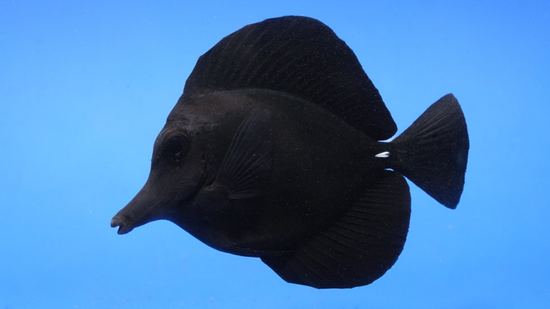Black Tang (Zebrasoma rostratum) – Quick Stats
- Care Level: Moderate
- Temperament: Semi-aggressive
- Diet: Herbivore
- Reef Safe: Yes
- Minimum Tank Size: 100 gallons
- Max Size: Up to 10 inches
- Water Parameters: pH 8.1-8.4, Salinity 1.023-1.025, Temperature 72-78°F
Comprehensive Guide: Black Tang (Zebrasoma rostratum)
Habitat
The Black Tang, also known as Zebrasoma rostratum, is native to the waters of the Pacific Ocean, specifically around the Hawaiian Islands. It inhabits coral reefs and rocky areas with plenty of hiding spots.
Reef Safe
The Black Tang is considered reef-safe as it does not bother corals or other invertebrates. However, caution should be exercised when introducing it to a reef tank with delicate corals, as individual behavior may vary.
Size
The Black Tang can grow up to 10 inches in length, making it a medium-sized fish suitable for larger saltwater aquariums.
Temperament
The Black Tang has a semi-aggressive temperament. It may exhibit territorial behavior, especially towards similar species or other tangs. Providing ample swimming space and hiding spots can help reduce aggression.
Sexual Dimorphism
Sexual dimorphism in Black Tangs is not visually apparent, as males and females have similar coloration and body shape.
Lifespan
The average lifespan of a Black Tang in a well-maintained aquarium is around 10 to 15 years. Proper care, nutrition, and a stress-free environment contribute to their longevity.
Diet in Aquariums
The Black Tang is a herbivorous fish that primarily feeds on various types of marine algae. A varied diet of high-quality seaweed sheets, dried algae, and occasional live/frozen foods like brine shrimp or mysis shrimp is essential for their health and vibrant coloration.
Aquascaping Recommendations
When aquascaping for a Black Tang, creating a well-structured environment with plenty of hiding spots and open swimming areas is important. Incorporating live rock formations and coral structures can mimic their natural habitat and provide them with places to explore and graze.
Captive Bred Availability
The Black Tang (Zebrasoma rostratum) is rarely available as a captive-bred species. Most individuals found in the aquarium trade are wild-caught. However, efforts are being made to develop successful captive breeding programs to help reduce the impact on wild populations.
Compatibility with Other Fish, Invertebrates, or Corals
The Black Tang can be kept with various tankmates, but care should be taken to select species that can tolerate its semi-aggressive nature and similar dietary requirements. Here are five specific tankmates that can be good choices:
- Hippo Tang (Paracanthurus hepatus) – Similar in size and dietary needs, the Blue Hippo Tang can coexist peacefully with the Black Tang.
- Bicolor Blenny (Ecsenius bicolor) – This small blenny species can occupy different areas of the tank and is generally compatible with the Black Tang.
- Firefish Goby (Nemateleotris magnifica) – These peaceful gobies can add a splash of color to the aquarium and are unlikely to be bothered by the Black Tang.
- Cleaner Shrimp (Lysmata amboinensis) – Cleaner shrimp can establish a symbiotic relationship with the Black Tang, providing cleaning services and entertainment.
- Montipora Coral (Montipora sp.) – This hardy coral species can withstand the grazing behavior of the Black Tang and add visual interest to the tank.
Other Common Names
The Black Tang is also commonly known as the Black Surgeonfish or Black Sailfin Tang.
Why Buy from Reefs4Less.com
Reefs4Less.com is a reputable online retailer specializing in saltwater aquarium supplies. Here are a few reasons why you should consider purchasing from them:
- Wide selection of high-quality fish, corals, and invertebrates
- Competitive prices and regular discounts
- Knowledgeable customer support to assist with any questions or concerns
- Fast and reliable shipping options
- Commitment to sustainable practices and responsible sourcing
Popular Questions and Answers
Q: What is the recommended tank size for a Black Tang?
A: The minimum tank size for a Black Tang is 100 gallons. Providing ample swimming space is important for their well-being.
Q: Can a Black Tang be kept in a reef tank?
A: Yes, the Black Tang is generally considered reef safe. However, caution should be exercised when introducing it to a reef tank with delicate corals.
Q: How often should a Black Tang be fed?
A: It is recommended to feed a Black Tang multiple times a day, offering a variety of marine algae and occasional live/frozen foods.
Q: Can Black Tangs be kept in pairs?
A: While keeping Black Tangs in pairs is possible, it is generally not recommended due to their semi-aggressive nature. Providing ample space and hiding spots can help reduce aggression.
Q: Are Black Tangs prone to any specific diseases?
A: Black Tangs are generally hardy fish but can be susceptible to common saltwater fish diseases like marine ich. Proper quarantine procedures and a stress-free environment can help prevent diseases.


Reviews
There are no reviews yet.